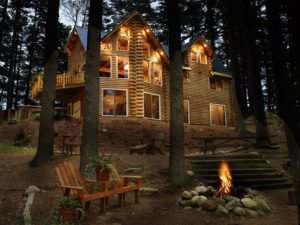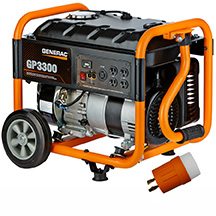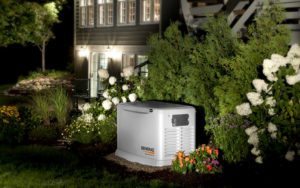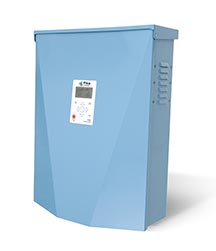 No matter where you build your Katahdin Cedar Log Home, there’s a pretty good chance you’ll lose your power at some point. Rural homes tend to be a bit more vulnerable, but recent storms have homeowners everywhere exploring ways to keep the lights on when the power goes out.
No matter where you build your Katahdin Cedar Log Home, there’s a pretty good chance you’ll lose your power at some point. Rural homes tend to be a bit more vulnerable, but recent storms have homeowners everywhere exploring ways to keep the lights on when the power goes out.
Start with Underground Utilities
Building a new home provides the opportunity to plan for power outages with home backup systems that are seamless and effective. An important start is with your home’s utility infrastructure. Even though it can cost a little more, most homeowners understand the value of burying your utilities from the main line to your home. In an outage, the connection between the main power transformer and your home is most often your responsibility to maintain and repair. Getting the power crews to repair your home connection will be a low priority call, especially if the outage is widespread. Going with underground utilities will also add value and aesthetic appeal to your home.
Design Auxiliary Power Capabilities into Your Home
One simple way to enhance your home is to provide electrical hookup wiring to your home’s main power panel. A heavy-duty generator hookup outlet and inverter can simplify access to back up power. Even if you opt for an on-demand or battery system, it’s worth the investment to be able to plug in a traditional gas or propane powered generator.
Next Question: Generate or Store?
This point is where your options become more diverse and more interesting, depending on your home’s overall systems and your lifestyle. Generators create power using gasoline, propane or natural gas. Battery storage is a great option for folks planning on solar but can also be useful for storing a reserve of electricity from the grid during off-peak pricing times.
Generators
Generators have come a long way in both design, power, and ease of use. There are two basic types of generators used by homeowners:
—Portable Generators — Portable generators can be powered by either gasoline or propane canisters. Getting the right size to power your household electricity demand is the key here. Generators are sized by wattage: for example, either 8Kw or 8000 watts. Some key features to consider:
- Electric Start makes generator operation easy for anyone. Pull start generators work well but need strength to get started. Select a generator with a rechargeable battery.
- Fuel Gauge — Knowing how much gas is in the tank is essential to avoid spillage, over filling and estimating usage time. You’ll avoid contaminating your gas tank when you have
 this built-in measurement tool.
this built-in measurement tool. - Gas Treatment — This pro tip will keep your generator’s small engine running great, even with infrequent use. A few ounces per 5 gallons will avoid the ethanol additive damage that gasoline can cause. Some experts also recommend using higher octane gasoline for their generators.
- Propane Tanks — If you opt for a dual fuel or propane powered generator, you’ll want to get a good estimate for how long a single tank will power your generator.
- Avoid Using Aviation Fuel — Some old-school generator owners rely on aviation gas to power their generators. However, the aviation gas formulation will cause engine valves to stick over prolonged use and will void your manufacturer’s warranty.
—On-Demand Generators — On-demand generators have become a standard feature for many new homes. They can  be powered by either propane or natural gas. The caveat for on-demand generators powered by utility-sourced natural gas is that depending on the circumstances, gas lines may be shut down during an emergency outage. If your home is relying on propane to fire heating and cooling, you may want to up-size your propane tank to accommodate an on-demand generator. Some key features to consider:
be powered by either propane or natural gas. The caveat for on-demand generators powered by utility-sourced natural gas is that depending on the circumstances, gas lines may be shut down during an emergency outage. If your home is relying on propane to fire heating and cooling, you may want to up-size your propane tank to accommodate an on-demand generator. Some key features to consider:
- Automatic Operation —On-demand generators provide a seamless operation, firing up the second a power interruption is sensed. For homeowners who travel frequently or those families with vital electrical powered devices, on-demand generation is an obvious choice.
- Service Availability — Though less of a factor now, when on-demand generators first landed in the residential marketplace, the service capabilities lagged behind. As with any appliance brand, you’ll want to ensure that factory-trained and reliable service is nearby.
 Battery Storage Systems
Battery Storage Systems
With the increased research into batteries primarily for the electric vehicle market, storing energy in homes has become both cost-effective and powerful. While often battery storage was considered an important component of solar power systems, new options for storing grid generated power make them a viable choice.
We’ve covered Tesla Power Walls and Sonnenbatterie systems in previous articles, but we’re impressed with the products manufactured by Pika Energy, a Westbrook, Maine based company. Their Pika Energy Island (above left), including the Harbor Smart Battery, offers a lithium ion battery energy management system that can collect solar and grid power and offer more power for longer periods of time than other battery storage options. Here are some of this system’s features:
- On-Demand Power — When the grid goes down, Pika’s Energy Island instantly and automatically takes over the power supply, without a flicker.
- Quiet, Clean Electricity — The Harbor Smart Battery was developed in partnership with innovative battery technology from Panasonic. Because the Pika Island stores energy instead of creating it, there’s no noise, fumes or refueling needed.
- Plenty of Wattage — Pika’s Harbor Smart Battery stores up to 15.9 kWh (kilowatt hours), 100% usable. The battery produces 10kW of peak power and 6.7 kW of continuous power, enough to keep the busiest household running.
- Scalable Systems — Two sizes of batteries provide entry level access at 10.5kW with the option of upgrading to 15.9 kW without needing a new housing tower.
- Smart Monitoring — The inverter also provides wireless monitoring technology that allows you to check on charge levels, operation and output right from a smart device.
 How Big a Battery?
How Big a Battery?
We spoke with ReVision Energy’s Fortunat Mueller about sizing a battery system for emergency backup. He explained that an average Maine home uses 600 kWh per month of electricity, about 20 kWh per day. “A battery energy system is typically sized not to cover 100% of the daily electrical use, but only the so called ‘critical loads,’” he said. “In most homes, this includes the heat, the well pump and sump pump if applicable, refrigerator and freezer, microwave, and then some fraction of the houses lights and outlets.” Large electrical loads like washer/dryer, electric range/oven, hot tubs or electric heat are typically excluded. “During a power outage those ‘critical loads’ for a 2,500 sq ft house are typically more like 3-10 kWh per day depending on the house, the occupant and the time of year,” Mueller said.
As most power outages are brief in duration, ReVision typically designs a battery system to cover about a day and a half of critical load, Mueller explained.
Seamless Solar Ready Integration
For Katahdin customers who choose our Solar Ready program, the Pika Energy Island can fold seamlessly into the design concept. Our partner ReVision Energy can include a battery storage solution to complement the solar array and HVAC energy efficiency recommendations in your new Katahdin Cedar Log Home.
